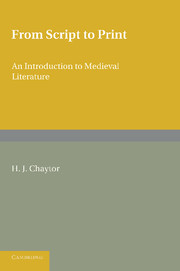Book contents
- Frontmatter
- Dedication
- Contents
- Preface
- Miscellaneous Frontmatter
- Chapter I Introduction
- Chapter II Reading and Writing
- Chapter III Language and Nationality
- Chapter IV Style and Criticism
- Chapter V Prose and Translation
- Chapter VI Publication and Circulation
- Chapter VII Conclusion
- Appendices
- Appendix A
- Appendix B
- Appendix C
- Appendix D
- Index
Appendix A
from Appendices
Published online by Cambridge University Press: 05 June 2016
- Frontmatter
- Dedication
- Contents
- Preface
- Miscellaneous Frontmatter
- Chapter I Introduction
- Chapter II Reading and Writing
- Chapter III Language and Nationality
- Chapter IV Style and Criticism
- Chapter V Prose and Translation
- Chapter VI Publication and Circulation
- Chapter VII Conclusion
- Appendices
- Appendix A
- Appendix B
- Appendix C
- Appendix D
- Index
Summary
Medieval Literature, written to be recited and primitive in character, naturally preserved certain syntactical mannerisms which were eliminated in the course of progress towards literary style, a process accelerated when individual reading became an amusement and the age of printing began. Early language is inclined to avoid subordinate clauses; the elaboration of the Ciceronian period is but little attempted, for the reason that auditors with acoustic, but with no visualising capacity, are likely to lose the thread of a lengthy sentence, unless it is presented to them in co-ordinate clauses. Hence we find loosely constructed sentences, either united by overworking the useful particles que and si, or put together without connection (asyndeton) in the assurance that the tone and emphasis given by the reciter will secure comprehension of the author's meaning. Pitet l'en prent, ne poet muer n'en plurt, is equivalent to a principal followed by a consecutive clause: ‘such grief comes over him, that he cannot help weeping’, and the hearer will instinctively draw this conclusion. If this possibility is doubtful, et may be used to mark the principal clause:
Que tan l'am de bon coratge,
c'ades soi entredormitz
et ab lui ai guidonatge.
(Peire d'Alvernhe.)‘For I love him so dearly that at once I fall asleep and I have his presence’, i.e. as soon as I fall asleep, etc.
Tantost con la lur mostra, e cascuna s'estent.
(Vida de Saint Honorat.)‘As soon as the saint shows the serpents the cross, then each of them is stretched out dead.’ Editors who attempt to amend this use out of existence probably regard it as an archaism; but it is common enough. The Latin simul ac, translated ‘as soon as’, is a parallel case (cp. also Fors et, Virgil, Aen. II, 139, ‘there is a chance that’, i.e. ‘probably’).
Que can be used to indicate a causal, concessive, consecutive or final connection; if ambiguity is likely, que can be qualified, per que, abans que, tro que, etc., but the reader or audience are often left to interpret the connection for themselves.
- Type
- Chapter
- Information
- From Script to PrintAn Introduction to Medieval Literature, pp. 142 - 144Publisher: Cambridge University PressPrint publication year: 2013



